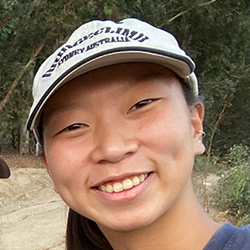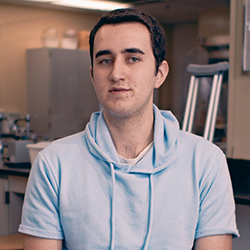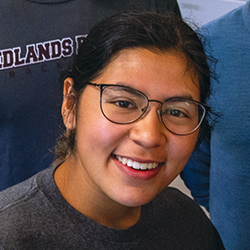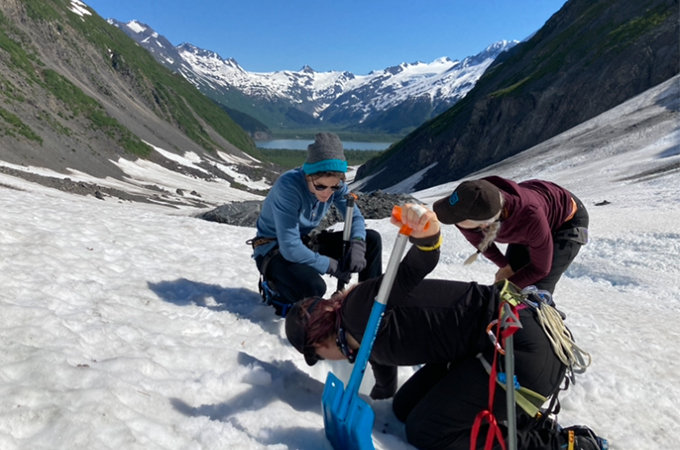Every year, the University of Redlands hosts the Student Science Research Program, in which around 30 students conduct hands-on, intensive research alongside their professors. The 10-week summer program allows students to live on campus during the summer and receive a stipend for their work, thanks to the endowment support made possible by the John Stauffer Charitable Trust and other generous donors.
Eric Hill, professor of physics and coordinator of the program, says the experience is a tremendous asset for students pursuing a career in science. Professors and students work on long-range projects, including tracking marine life off the Los Angeles coast with Professor Lei Lani Stelle, mathematical modeling with Professor Steve Morics, and surveying bears and other wildlife at the Bear Paw Reserve with Hedco Chair for Environmental Studies Wendy McIntyre. Participants are chosen each year from dozens of applications.
Many students create their experiments, with the support of professors who help them troubleshoot their projects. “It's really rare for undergraduates to be this involved in research,” says Shaun Weatherly ’22, the Lewis Student Science Researcher. While many universities permit undergraduates to conduct research in federally funded projects, those students are usually only allowed to work on one or two problems; adds Morics. “At Redlands, you get a lot more freedom to work on your experimental design.”
At the end of 10 weeks, students showcase the results of their research at a poster symposium.
Here’s what a few students have to say about their experience.
Chloe Levine ’22, Levings Student Science Researcher, biology and math major with a studio art minor

Research: Gathering baseline arthropod population data for grassland restoration at Redlands Gateway Ranch with Professor Dustin Van Overbeke
Why it's important: “Invasive plant species cause many pollinators and ground-dwelling arthropod populations to decline because they're not used to pollinating and feeding off those plants,” Levine says. Her team set out pan traps weekly to entice pollinators such as bees. “We want to see if the abundance and diversity of arthropod populations will improve as native plant species are restored and whether they will replace invasive species after 10 to 15 years.”
What’s next? “After graduation, I plan to earn my Ph.D. in entomology to go into the forensic entomology field.”
Suphanat Isarangkoon ’22, molecular biophysics emphasis at the Johnson Center for Integrative Studies

Research: Loma Linda University donated a decommissioned scanning electron microscope to U of R; Isarangkoon is figuring out how to get it up and running with Professor Eric Hill. He also helps Hill prep for advanced lab classes.
Why it’s important: “The scanning electron microscope will allow us to see detailed cell structures and is roughly 500,000 times more powerful than anything we currently have. If we can get it to work, it will help students in the physics, biology, and chemistry departments conduct their research.”
What’s next? “At Johnston, I combined my interest in molecular biology with my interest in physics to study the molecular dynamics of proteins, protein structures, and protein binding. My summer research project helped prepare me for graduate school in those fields because I gained enhanced experience in the physics department. After graduation, I plan to pursue a Ph.D. in biophysics and become a research professor in that field.”
Rylie Weaver ’22, Hunsaker Student Science Researcher, math and physics major with a computer science minor

Research: Studying necessary and sufficient conditions for monotonicity failure in ranked-choice voting with Morics. “I'm a math major, but politics is kind of a side hobby, so this project was really cool for me.”
Why it’s important: “Monotonicity is one of many criterion we have to evaluate how good an election system is,” Weaver says. “I want to be able to look at a voter profile, the election results, and tell if it's possible that ranked-choice voting has caused a monotonicity failure in that election. Eventually, my research can allow us to evaluate whether we want to use ranked-choice voting or not.”
What’s next? “I plan to go to graduate school. I like algebra, and I like cryptography, too, so I could see myself using [methods I used in this project] in the future and getting a job in codebreaking.”
Summer Brown ’22, chemistry and history major
Shaun Weatherly ’22, Lewis Student Science Researcher, biology and chemistry major with a physics minor


Research: Modeling the mass transfer of a pollutant known as nonylphenol through glacial environments and characterizing its biodegradation by bacteria (Pseudomonas aeruginosa) in the Sierra Nevada Mountain range
Why it’s important: By looking at nonylphenol’s uptake, transformation, and subsequent release by these glaciers through meltwater, we can gauge its effects on downstream environments and ecosystems, says Weatherly. Brown adds, “Nonylphenol is an endocrine-disrupting compound that mimics estrogen in the human body, which has been linked to testicular, breast, and endometrial cancer. Nonylphenol is a surfactant that’s in many pesticides, so it tends to accumulate in areas where there's heavy pesticide use, like the Central Valley, where the Sierra Nevada is located. About 62% of Los Angeles County sources its water from the Central Valley, so all that nonylphenol comes downstream into our water.”
What’s next? Brown says, “I want to get a Ph.D. in either polymer chemistry so I can make alternative chemicals that are less harmful toward the planet and human health, or molecular and environmental toxicology to study how chemicals affect the human body and create research that can influence policy.” Weatherly, who is aiming to earn a Ph.D. in physical chemistry, says, “Putting forth original thought into the world and contributing to humanity's greater collective knowledge seems like a worthy endeavor.”
Amber Francis ’22, environmental science major with human and animal studies and spatial studies minors

Research: Monitoring the human effects on marine mammals off the Los Angeles coast with Stelle. “We go out on a whale-watching boat a couple of times a week to document marine mammal behavior and the boats around them. We also watch sea lion behavior. We document vessels that approach them and how it affects the sea lion behavior.”
Why it’s important: Understanding how humans affect animals and laying the foundation for further research on how mammals change their behavior.
What’s next: “I hope to continue studying at America's Learning Zoo, where I can work with exotic animals, learn about husbandry, and also work on conservation projects.”
Learn more about undergraduate studies at the College of Arts and Sciences at the University of Redlands.






